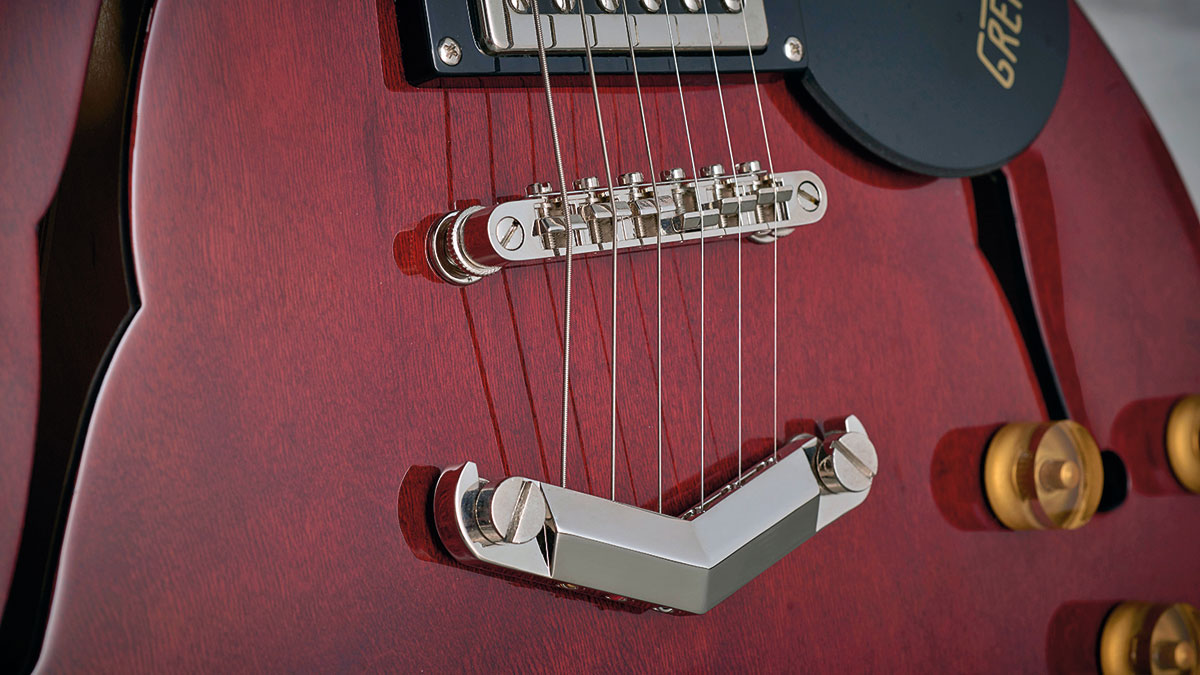MusicRadar Verdict
The G2622 might well be the bargain 'ES-335' we've all been waiting for.
Pros
- +
Ditto the G2420T, but the centre block widens its use at higher gains/volumes.
Cons
- -
The same faults as the G2420T; high-fret access isn't as good as an ES-335.
MusicRadar's got your back

Gretsch G2622 Streamliner

Gretsch G2622 Streamliner
The Streamliner concept is simple: to create more affordable Gretsch guitars without losing their specific DNA.
So, this new electric guitar range centres on three body styles: the large 406mm (16-inch) wide G2420T; the same-sized double-cut thinline G2622, with spruce centre block; and a downsized 340mm (13.375-inch) wide Junior version, the G2655. There are two Bigsby versions of each model (the only difference being the sole colour they are offered in), and one hardtail version that, along with a single G2622 lefty, creates a 10-strong range.
Despite the different styles, there are just two prices: the non-Bigsby versions cost £350; the Bigsby-equipped models and the lefty are £395, pretty much half the price of the existing Electromatics.
The Streamliner models share a majority of features. Each has two new Broad'Tron humbuckers controlled in classic Gretsch style by a three-way toggle selector switch on the bass side shoulder, a master volume on the treble side horn, and then a trio of controls by the treble-side f-hole for individual-pickup volume and master tone.
Construction follows the hollow/semi protocol of laminated maple top, back and sides, although on the G2622 and G2655 there's a new-design centre block that is mainly hollow. Allhave the same slightly longer scale length of 629mm (24.75 inches), bound rosewood 'boards, a 305mm (12-inch) radius, and the same profile nato (as opposed to maple) necks.
Gretsch is calling the frets 'medium jumbo', though at approximately 2mm wide and 0.9mm high we'd say that's a misnomer - they are certainly smaller than the 'medium jumbo' wire of the Electromatics, which measures approximately 2.65mm wide with a pretty similar height.
Then there are the large block fingerboard inlays that nod back to the 70s; the headstock outline follows the classic 6120 shape with a gold logo and no series name while the smaller size f-holes follow those from Gretsch's Baldwin-owned era (1967 to 1980).
Want all the hottest music and gear news, reviews, deals, features and more, direct to your inbox? Sign up here.
The clear-topped acrylic control knobs, with either gold or black coloured bases, actually revisit a design used by Gretsch in the early 50s, before knurled metal knobs, while the 'teardrop' pickguards emulate those on the Duo Jet.
Gretsch's double-cutaway guitars appeared in the early 60s and adopted a clearly inspired-by but different outline to the Gibson ES-335 - notably their flatter, less pronounced horns. They were also hollow, without a centre block, which didn't appear until 2013. While the body width is identical to the G2420T, the depth is trimmed at the rim from 72mm to 47mm.
As we've reported, an ES-335-style guitar can be surprisingly heavy thanks to its all- solid mahogany or maple centre block. Our sample, however, is a shade lighter than the G2420T, which is certainly in part due to the unique design of the centre block - essentially, two strips of spruce that run down the centre of the guitar, connecting top to back and anchoring the pickups, bridge and tailpiece but leaving a gap in the middle from just past the neck pickup to the base of the guitar.
The other primary change here is the hardtail bridge and tailpiece setup. The Adjusto-Matic screws into metal ferrules and the strings are anchored by a 'V' shaped stud tailpiece designed specifically for these guitars.
"The V shape makes it very Gretsch-y," says Gretsch's Adam Bowden- Smith, "like the Cadillac tailpiece or the big V cut-out on the Gretsch-branded Bigsby. We wanted to make the effort so the Streamliners aren't copies of ourselves; we wanted to make them our own." The Bigsby version uses the B70 style with tension bar, which will add weight and alter the balance compared with our hard-tail version.
Sounds
The G2622 is slightly neck-heavy, but the upper horn strap-button placement means it sits quite conventionally. And strapped on, it's far from balanced.
The G2622's construction gives a different response and resonance to other new releases from Gretsch and, with these pickups, moves further from the Gretsch sound. And while its construction gives it a more solid, or at least ES-335, character, it's a little more airy and less punchy with a softer, squashier tonality, for example, compared with a lower output Guild Newark St Starfire V.
More guitar for less money will continue to be a theme this year. It will be interesting to see if any major brands manage to do it quite as well as Gretsch has done here.
But are we really getting a half-price Gretsch? Yes and no. The beefier pickups certainly don't nail a classic Gretsch tonality - although if that's what you want, the full- size pickups are easy to replace - but they do broaden the sonic potential, especially for more gained styles, while staying close to the classic iconography.
- Our pick of the best guitars for beginners
- More of the best electric guitars under $/£500
Dave Burrluck is one of the world’s most experienced guitar journalists, who started writing back in the '80s for International Musician and Recording World, co-founded The Guitar Magazine and has been the Gear Reviews Editor of Guitarist magazine for the past two decades. Along the way, Dave has been the sole author of The PRS Guitar Book and The Player's Guide to Guitar Maintenance as well as contributing to numerous other books on the electric guitar. Dave is an active gigging and recording musician and still finds time to make, repair and mod guitars, not least for Guitarist’s The Mod Squad.
